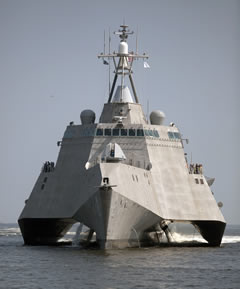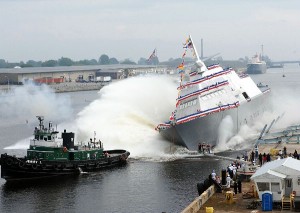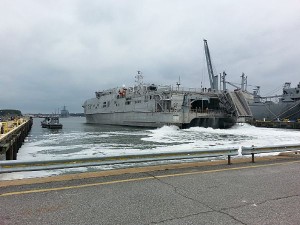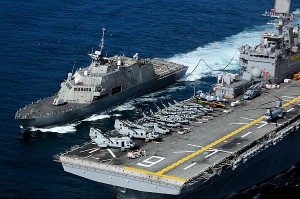In an elegant bit of Washington subterfuge, news “leaked” this week that the Littoral Combat Ship program is to shrink from 52 to 32 ships. This is a fascinating example of underhanded Washington drama, and it deserves added scrutiny.
BACKGROUND
So here’s the deal. Sometime in the past ten days, somebody in the Pentagon leaked a portion of a classified memo that dealt with the LCS. This was not just any memo–it was a budget directive that Ms. Christine Fox wrote and, well, just happened to sign while she enjoyed her first full day as Acting Deputy Secretary of Defense.
And, as is typical for most things bad about the LCS, somehow only the anti-LCS portion of the memo landed in the press. Once the memo was generated and disseminated, the leak could have come from anywhere–Navy, OSD, anywhere–there are enough LCS-haters in DC that the folks who really wanted this anti-LCS news “out” were the ones who helped craft the guidance–others were left to do the dirty work of leaking.
As far as timing, well, this leak of classified information was exquisitely well-timed. I speculate that Chris Cavas, the Defense News scribe who broke the story, received the leak sometime Tuesday evening or Wednesday morning–Chris certainly seemed busy Wednesday. He was a targeted recipient of the leak–his story was far, far ahead of his usual anti LCS rivals–particularly the usual go-to anti-LCS reporter, the Bloomberg anti-LCS “Editorialist” Anthony Capaccio (Tony is s a good Defense reporter, but on LCS, he’s simply too eager to foment anti-LCS policy to serve as a factual reporter on things LCS).
 Anyway, Chris is no dummy. He knew Navy leadership had just finished a second day of emphatic LCS boosterism at the Surface Navy Association’s annual meeting, and he was scheduled to speak to SNA on Thursday. So he wasn’t going to hold the story. To create maximum buzz, his scoop went live during the festive Surface Navy Association “Happy Hour”.
Anyway, Chris is no dummy. He knew Navy leadership had just finished a second day of emphatic LCS boosterism at the Surface Navy Association’s annual meeting, and he was scheduled to speak to SNA on Thursday. So he wasn’t going to hold the story. To create maximum buzz, his scoop went live during the festive Surface Navy Association “Happy Hour”.
Amazing.
The leaker certainly knew what he or she was doing. The person got the right tool in the right place and time to kill any momentum LCS might have garnered from the SNA convo going into the budget discussions.
Aside from the proposed cut to 32 ships, here’s the particulars from Defense News:
The decision, in a Jan. 6 memo from acting deputy secretary of defense Christine Fox [Who had been appointed to “acting” only three days prior], came after the Pentagon received its final 2015 budget guidance from the White House. Several major acquisition decisions, including direction on what to do with the LCS program, were awaiting the numbers from the Office of Management and Budget.
Bloomberg kicked it downfield:
The directive to scrap 20 of the planned ships came in one sentence of a memo to the Navy from Acting Deputy Defense Secretary Christine Fox, according to defense officials who asked not to be identified before a public announcement. Fox also raised the possibility of building a replacement vessel, one of the officials said.
So here we are. What does this leak mean? Let’s speculate on some of the less obvious winners and losers.
LOSERS:
Robert O. Work’s nomination as Deputy Secretary of Defense: An OSD-led attempt to cut the LCS complicates Mr. Work’s potential nomination to serve as the Deputy Secretary of Defense. Look. The LCS is his ship. He’s always been the penultimate LCS cheerleader. So it makes certain sense that, after reports came out in late December that Mr. Work was headed for the nomination, that opposition would emerge and crystalize around Mr. Work’s big achievements. The most controversial–and most obvious–is LCS.
 If appointed, Mr. Work would land on OSD like a hawk on a big, fat chicken. And between those in OSD who simply hate the LCS (Like, oh, Mike Gilmore, the OSD’s director of operational testing)–who, under Mr. Work, would likely fear for their jobs, and those who, well, either hate Mr. Work or, um, want the Deputy job for themselves (Like, oh, maybe, say, Christine Fox (And yes, this is just a speculative WAG), there is sufficient incentive to use the LCS as a hail-Mary means to hinder Mr Work’s nomination (or, maybe it is an attempt to ram a decision through before Work is nominated–Or maybe it’s a sign that Work’s nomination is a non-starter. It’s hard for this observer to tell). Anyway, add in whatever might be coming from the Glenn Defense Marine Asia scandal, the silencer scandal (which just claimed a Mr. Work’s “acting” replacement and his former subordinate at CSBA, Robert Martinage) and other emergent messes (gasp!), there might be enough controversial “smoke” to make the White House have second thoughts on advancing Mr. Work to the Pentagon’s #2 post.
If appointed, Mr. Work would land on OSD like a hawk on a big, fat chicken. And between those in OSD who simply hate the LCS (Like, oh, Mike Gilmore, the OSD’s director of operational testing)–who, under Mr. Work, would likely fear for their jobs, and those who, well, either hate Mr. Work or, um, want the Deputy job for themselves (Like, oh, maybe, say, Christine Fox (And yes, this is just a speculative WAG), there is sufficient incentive to use the LCS as a hail-Mary means to hinder Mr Work’s nomination (or, maybe it is an attempt to ram a decision through before Work is nominated–Or maybe it’s a sign that Work’s nomination is a non-starter. It’s hard for this observer to tell). Anyway, add in whatever might be coming from the Glenn Defense Marine Asia scandal, the silencer scandal (which just claimed a Mr. Work’s “acting” replacement and his former subordinate at CSBA, Robert Martinage) and other emergent messes (gasp!), there might be enough controversial “smoke” to make the White House have second thoughts on advancing Mr. Work to the Pentagon’s #2 post.
If Mr. Work is the nominee, making LCS an issue gives the Senate Republicans on the Armed Services Committee an opportunity to sweat Mr. Work a bit (somehow they seem to forget that one LCS is produced in a firmly Red state) and to derail what would have been a very easy and politically painless “coronation” of Mr. Work.
In the end, anything that makes Mr. Work expend political capital during his nomination will reduce his immediate effectiveness in reigning in some of the out-of-control elements of OSD–the very folks who would fear for their jobs under Mr. Work’s tough management.
Department of the Navy and Navy Leadership: Every naval leader who said anything positive about LCS at the big Surface Navy Convention–from SECNAV Ray Mabus to CNO Admiral Greenert on down to N95 and N96–got poked in the eye by this leak and it’s leaker.
 I am embarrassed for all those officers. They did their duty, promoted the LCS and did their level best to raise morale with the rank-and-file, only to be promptly trumped by some darn…leaker with a grudge. Yeah, Admirals are no strangers to bare-knuckle politics, but, even by Washington standards, this was quite a tough rebuff from somebody who really wanted to give the Navy a headache.
I am embarrassed for all those officers. They did their duty, promoted the LCS and did their level best to raise morale with the rank-and-file, only to be promptly trumped by some darn…leaker with a grudge. Yeah, Admirals are no strangers to bare-knuckle politics, but, even by Washington standards, this was quite a tough rebuff from somebody who really wanted to give the Navy a headache.
But it’s not just the Admirals. It’s the sailors–the surface warriors–who didn’t deserve such treatment. Morale matters. I mean, imagine if you’re a young surface warfare officer, and you sit though the pep rally, buy into it, and then go home, to find out that, well, pretty much everything your leaders told you about the neat new platform you’re fired up about serving upon…is wrong and untrue. This is bad for everybody in the Chain of Command, and I’m outraged. And I hope the Admirals who got p’unked are as furious as I.
It would have been far more polite–and productive–had this leak occurred in the run-up to the SNA, when, at least, there could have been some constructive dialogue.
But this leak was not meant to be polite.
Small Shipyards in the Small Navy Ship Business: Something must be done to modify procurement of smaller naval vessels. With a build-cycle of a year or two, and a requirement to go “back to the well” every year to beg for the program, the opportunities for disruption are enormous. For small ships, multi-year buys don’t give the security smaller shipyards need to succeed.
If the current system is allowed to stand, investors and workers in any small yard-any small yard dedicated to building small naval craft–must be prepared to weather an enormous amount of programmatic uncertainty. This is uncertainty that investors in the larger naval shipyards–with their longer build cycles and enormously large projects–do not share.
First off, the ability of a larger shipyard (with multiple projects that end 5-7-even 10 years after contract award) to ride out programmatic disruption is far greater than a smaller yard dedicated to building smaller ships (i.e. projects that end three or less years after contract award).
years after contract award) to ride out programmatic disruption is far greater than a smaller yard dedicated to building smaller ships (i.e. projects that end three or less years after contract award).
Readers of this blog know that fleet numbers oscillate all over the place. But with larger ships, a contractor has years to build a strategic or operational case with stakeholders, while, with smaller ships, smaller contractors have mere months before they must start dismantling. Adding insult to injury, smaller ships are far easier to move around on the long-term shipbuilding plan chessboard, and are often the poor bloody infantry to be sacrificed for far larger programs.
We also learned in the LCS program–with LCS-3 and 4–that it is far easier for bureaucrats to cancel poor-performing small ship contracts than, say, a poor performing CVN build-out. While a CVN is too big to fail, similar disruption with smaller ships is seen to be prudent management.
Couple those competitive advantages with scale. Even with exactly the same profit margin, a big 25,000 person shipyard, working on projects that are 10 times more costly than the projects given to a smaller, oh, say, 4,000 person shipyard–the small yard is at a disadvantage. If managed well, the big yard is going to come out ahead every time.
And that’s not all. Congress just keeps on giving the big guys more and more long-term security. Investors agree. Look at the two-year stock charts of a small naval shipyard versus, say, Huntington Ingalls, and you’ll see what I mean. HII’s stock has almost doubled to about $90, while the other, an LCS builder, has slumped to under a buck.
There are some other realities, too. Add in the fact that large ships are far less controversial than smaller ships. DDG-1000–despite acknowledgement that the composite bridge doesn’t work (and was eliminated!!), and given that the small DDG-1000 crew is going to be even more overwhelmed by their tasks than the LCS crew, nobody is debating it. Nobody cares. (LCS and the DDG-1000 both lack bridgewings–while, gee, while nobody discusses the DDG-1000, the LCS handwringing over bridge visibility is almost comical.). DDG-1000 has yet to enter the fleet, and discussions are already focused on “we should we buy more, right? How many?”
In the end, smaller ships are exercises in compromise, leaving everybody unhappy (until after the ships get into service, that is). Larger ships are all about accommodating possibilities–everybody gets to play, everybody wins and there’s usually some neat hi-margin tech hidden somewhere in the large-ship easter egg.
And, finally, we’ve got to count in the impact of competition. For Navy business, the barrier for entry for small yards is far, far lower than for larger yards. Any small ship contract will be fought-over by an enormous number of desperate and hungry yards. Inexperienced yards will make their margins razor-thin and cut their bids down to the bone. In contrast, the big yards, with their big-ship contracts, remain sedate, government-supported monopolies, where the “competition” between them is, well, pretty much a sham. There’s certainly plenty of lard left in those fancy big-ship contracts.
Even though I laud Sean Stackley’s efforts to keep both taxpayers and the defense industrial base healthy, at the end of the day we still have monopolies. One big yard builds CVNs, another LHDs, a different one makes auxiliaries, and another specializes in big surface combatants. While nominal competitions go on for DDG/SSN work, they’re dolled out in some kind of friendly and dignified “workshare” program where both sides win–it’s just a matter of how much.
With LCS it wasn’t supposed to be this way. The LCS program did drive business towards smaller shipyards who traditionally didn’t do military/government work. But the LCS was also meant to help supplement commercial yards and help break up the big-shipyard monopoly on naval shipbuilding. That hasn’t happened. Instead, the big yards helped inject sufficient programmatic uncertainty into the LCS program that the next small Navy combatant will–I strongly expect–be a project won by a traditional big-Navy yard, with predictable, far-overpriced results. I’ll be frank–the LCS cost-growth is NOTHING like the cost growth demonstrated by the National Security Cutter program. And we’re setting ourselves up for a similar story ten years from now.
There must be some sort of reform to help level the playing-field so that small-ship manufacturers can actually do well. I don’t know what that might be, but large shipyards have a competitive advantage their smaller brethren do not share.
And that is wrong.
WINNERS:
The Joint High Speed Vessel: If the LCS cuts hold, the JHSV will become the de-facto LCS (Ironically enough, the JHSV is more along the lines of what Bob Work may have envisioned in the first place–a cheap variant of a civilian vessel capable of being built in numbers). Numbers matter–while the LCS is being forced to jump though one hoop after anther (DOT&E testing, Mission Module Testing, Shock Trials, CONOPs experiments, etc. etc…), the JHSV is out there. Doing stuff. And it is entering the fleet at a great clip.
 At some point, JHSV will become the only small Navy platform with the “free time” to actually support the fleet’s ever-growing mission-set. LCS deployments are scheduled out for years in advance–there’s no “free play” for the LCS. For JHSV, the number of hulls means that a JHSV will likely be available to support hard-pressed combatant commanders–and that availability will, in essence, demonstrate and prove out the LCS concept far faster than the LCS itself. By being there, JHSV will start assuming FFG-like roles just out of sheer necessity. There’s simply no other ships available.
At some point, JHSV will become the only small Navy platform with the “free time” to actually support the fleet’s ever-growing mission-set. LCS deployments are scheduled out for years in advance–there’s no “free play” for the LCS. For JHSV, the number of hulls means that a JHSV will likely be available to support hard-pressed combatant commanders–and that availability will, in essence, demonstrate and prove out the LCS concept far faster than the LCS itself. By being there, JHSV will start assuming FFG-like roles just out of sheer necessity. There’s simply no other ships available.
The JHSVs have potential to be far more successful at pushing innovation into the fleet. Don’t believe me? Well, JHSV already had a contract let to design in Firescout C capability. On LCS, they’re only just now talking about it. I think I heard from CNO’s talk at SNA that JHSV will be testing railgun in 2016. LCS? Crickets. ISR, irregular warfare, you name it…Pick almost anything you’ve heard about LCS doing missions beyond Mine Warfare, ASW and Anti-Surface Warfare, and the JHSV has already gone there.
So while LCS still teethes (and teethes and teethes) it’s way towards an untimely cancellation, the flexibility of MSC and the civilian crew will be on full display. The JHSV’s crew of 22 will do things that the Navy cannot do with a crew of 100+. MSC ships routinely vanish for months at a time–no crew swappy hand-wringing there. MSC platforms just go–they don’t need no stinking CONOPS! And, mark me–we all cheered LCS-1’s 9 month deployment. Guess what? JHSV-1 is, essentially, headed out until the end of FY 14. Nine months. No home port. Think about it. And then think about how much more operational time it’ll chalk up. (If you don’t think that sked was developed to be a deliberate goad to the LCS, well, I got news for ya.) Barring total disaster, JHSV’s first deployment is gonna make LCS-1’s Singapore deployment look like amateur hour. And by being out there, in action, it’ll put to rest the tired old OSD-led distractions about aluminum-ship survivability and crew fatigue and so on. (Weigh survivability against getting the mission done, and the mission will win every time.)
Hopefully MSC will be allowed to promote the JHSV’s first deployment as much as big Navy promoted LCS. But, knowing MSC, they’re too busy trying to convert their teeny tiny pile of cash into additional sailing time for all their other hard-working, high-demand assets.
Anyway, JHSV, as a platform, costs less to procure and operate than LCS, offers similar easy-upgrade capabilities as LCS, good margins for growth…and, well, it’s just going to be out there, doing good work. And by getting out in the field, the JHSV escapes the constant drumbeat of OSD-stimulated disruption and contractor-mediated sabotage. (And, as an aside, the JHSV–as a small ship program–has seen enormous disruption too–going from an expected 20+ hull program to a 10-ship-and-done Program of Record.)
It is also, in a business sense, a safe platform-only one company builds JHSV, while lots and lots of folks want to build LCS wannabes. JHSV also has a great manager at NAVSEA, a wily character who is specializing in getting interesting do-it-all, MSC-manned ships into the fleet quickly, without undue disruption from the test-and-trials folk. And then there’s Alabama. Try and cut LCS without compensating the state with other work, and Alabama’s powerful Congressional delegation will make the Pentagon suffer. Which leads me back to my original theory–cut the LCS and there are going to be far more JHSVs in the field far faster than anybody expected. So…mark my words. Cancellation of the LCS will make JHSV the de-facto LCS until the U.S. Coast Guard OPC platform is militarized and built in numbers (Five remaining OPC builders look up from kicking the prone and bloody LCS program, blink twice, put hands in pockets and start walking quickly away).
Military Sealift Command and Civilian Mariners: Every day the JSHV is out there is a day where the lean-and-mean MSC is out demonstrating the value of civilian mariners.
I touched on this issue earlier–but as the MSC is increasingly integrated into mainstream warfighting roles, the uniformed Navy might do well to start wondering about their role. Maybe–just maybe–it’s time for Surface Warfare to shed their sea-driving duties and focus on, well, surface warfare, and leave shipdriving to the civilian specialists. MSC ship-drivers cost-effective, and have–on average–far more sea-time than the average Navy Commander. Put another way, you sure don’t see MSC ships grounding, crashing and darn near sinking as often as you do with Navy ships. MSC shipdrivers drive ships. Surface Warriors, I think, probably don’t really need to.
Again, I’m speculating–and I will write more about this–but it might be best if Surface Warriors get re-directed to start managing the battle network, and really owning that. Competence in ship-driving (in getting the windward gage or whatever) is becoming comparatively less important in battlespace terms. Let the green-haired, nose-ringed pirates run the ship while surface warriors fight!
CONCLUSION:
So…what’s going to happen? I have no idea! It’s all a fascinating drama. But I’d love to hear what you all think. I know I’ve dropped a few controversial ideas here, but I think we’d all do well if we discussed some of the topics I’ve brought up at greater length. Should MSC assume more roles from the Navy? Will JHSV become the Next-Gen light Frigate? Will DOT&E win in their effort to direct DOD policy? Are we doing the best we can in being good stewards of the defense industrial base? Who knows….But it’s all fascinating stuff that is well worth wider discussion. Have at it!



{ 7 comments… read them below or add one }
Greg; I am not in the Navy loop but I believe your giving the whole story excessive drama value and any senior Navy leaders at the meeting that were unaware of the decisions had to be willfully ignorant.
DC isn’t sneaky, brilliant or malicious. Plodding, systematic and compartmented are all better descriptions. While Ms Fox may have signed a decision memo, you can be assured the major options leading to that decision were many months in study and discussion prior to the issue reaching the DEPSECDEF. Further, while some things might be classified, I believe the shipbuilding plan has to go to Congress and the modifications have to be reported out unclassified to the Committee heads well before anything else is seen in public. While the timing was ‘unfortunate’ for the SWA conference – dumb luck on the timing is at least as likely as dark malicious intent. Alas stupid stuff isn’t nearly as good press as conspiracy.
We will have to wait on just how well the new JHSV does, as we have no experience with just how well the new version does. Still the older versions did well enough for a light transport. Where the JHSV will get in trouble is when they start increasing their cruising range. Cruising on one diesel will likely double the range, but that still half what the LCS are required.
And adding weapon systems, full time helicopters support, and other military type requirements will surely boost the cost and manpower requirements. By the time this happen we very likely be back to the same cost and manning requirements as the LCSs.
And interesting milestone to watch for will be the day the Navy asks Congress to pay to enclose the JHSV “parking spot” with a proper hangar. The faster that happens, the more LCS-type missions the type will be able to support.
I’m not as dead set against the Coast Guard using LCS as Eric is, assuming they only temporarily replaced the Reliance Class 210 foot cutters until the Offshore Patrol Cutters are finished. .
Most of the range criticism I have heard was in reference to the Freedom class (3550 miles @18) rather than the Independence class (4300 miles @20) which have been more economical throughout he speed ranges.
Even the Freedom class could probably perform all the 210’s missions at least as well as the Reliance class, if they had an adequate crew.
The Offshore Patrol Cutters are to have a minimum 7,500 mile range @ 14 knots.
The Hamilton Class have a 14,000 mile range at 11 knots. The 2,400 mile figure would probably apply at 29 knots while using both gas turbines.
The cutters are all made to run economically at low speed. The Famous Class can cruise almost 10,000 miles and the Reliance class 8,000 @12 knots.
That’s not true.
Range of an LCS-2 Class at full load and 20 KT is 4,300 nm. Range increases considerably at lower speeds.
Hamilton Class range is 2,400 nm at 19 KT. (NSC Cutter claims 12,000 nm, but no speed is attached.)
Famous Class range is 3,850 at 19.5 KT
Reliance Class range is 2,700 at 18 KT
trust me the coast guard doesn’t want the lcs. most coast guard ships work alone more often then not. the lcs is too short legged. coast guard ships don’t have the luxury of dragging an aoe or aor around with them. i’m willing to bet the new opc’s, if and when we see them will have a better range. besides we’ve had to put up with navy hand me downs before. thanks but no thanks.
I would not feel sorry for the surface Navy who has bet their careers on the LCS.
The LCS design doesn’t meet the specifications that prompted the program, and that was before systems started failing.
The LCS is an overly complicated ship with a few advantages (a large flight deck, high sprint speed and modular mission modules) but major disadvantages (very limited firepower, limited redundancy, requires a highly trained crew).
In my opinion as a non-surface Navy officer, we have built a coast guard cutter and painted it gray. If we are looking for warships, we need to start over, but at least the Coast Guard can probably use the ships we have built so far.